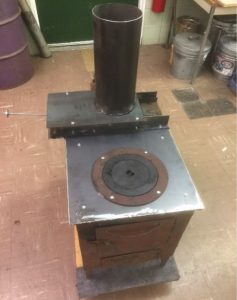How to Install a Catalyst in an Existing Heating Stove
How to Install a Catalyst in an Existing Heating Stove
When starting a cold stove the catalyst is disengaged from the gas stream by pulling on a steel rod. A green light will indicate when the stove gases are above 600F. The catalyst can then be engaged by pushing in the rod.
In one experiment in the ARC lab the installed catalyst reduced the emissions of PM 2.5 in a simple steel box stove made in Mongolia to about 1g/hour which meets the 2020 EPA Heating Stove Standard.
The following is a summary of a January/February 1983 article from Mother Earth News that describes design principles for installing a catalytic converter in a wood burning stove:
- Ceramic or metal catalytic converters are coated with platinum and/or palladium and/or rhodium.
- A catalytic converter can reduce the ignition temperature of carbon monoxide and hydrocarbons from upward of 1300°F to the 500-700°F range.
- Once the smoke passing through the catalyst reaches that threshold, it will oxidize as long as the combustibles in it are well mixed with a sufficient supply of air.
- After it is “lit,” the converter will produce enough heat to maintain ignition, even though the temperature of the incoming “wood gas” may drop slightly below 500°F.
- The basic concept can be applied to just about any roughly cubic metal (steel or iron) wood burner.
- Since the converter must reach a temperature of at least 500°F before it “lights off,” a location close to the fire will insure that the unit starts working as soon as possible and continues to do so throughout the burn.
- It is strongly suggested that a baffle arrangement is incorporated, diverting flame, residues, and ash, since eliminating the baffle could result in drastically shortened catalyst life.
- There must be adequate oxygen at the catalyst, however, it was determined that specific provisions for secondary air weren’t needed. Under all burn conditions, there was always an adequate air supply remaining at the converters.
- Hotter air (both primary and secondary) means better performance. Well warmed primary air encourages efficient primary combustion, and hot secondary air is vital to maintaining ignition temperature at the catalyst.
- A well sealed, strong bypass valve is mandatory. Even though the cell structure of the catalyst is relatively open (in comparison with that of the automotive variety), the unit does restrict natural draft to some extent, particularly when the catalyst isn’t lit. For that reason, there must be a valve that allows you to shunt smoke around the catalyst while a new fire gets going and whenever the stove’s doors are opened.
- As we’ve already mentioned, the single most important precaution is to always bypass the converters when the doors are opened. Furthermore, that same valve will have to be open while you’re getting a fire going.
- And should the catalyst go out for some reason, we’ve found the thermometer to be the only easy way to tell.
- After the charge of wood burns down — but not out — you can open the bypass, add more fuel, and then close the bypass immediately.
- Materials such as coal, wood pellets, paper with colored ink, tires, plastics, and treated or painted lumber, may “poison” the catalyst and render it ineffective.



Leave a Reply
Want to join the discussion?Feel free to contribute!